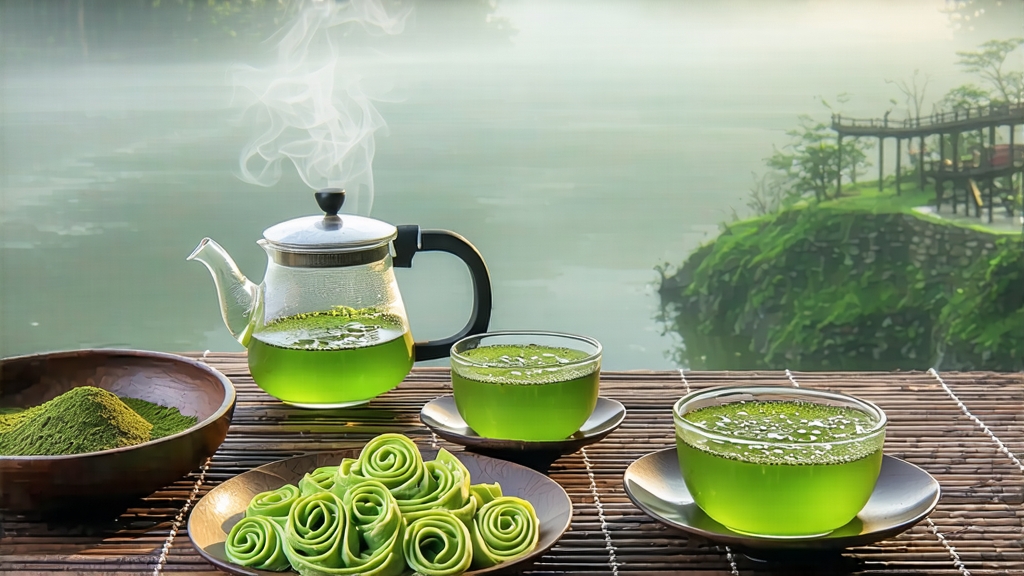
Biluochun, whose name literally means “Green Snail Spring,” is one of China’s ten most celebrated teas, yet it remains a delicate secret outside serious tea circles. Grown on the mist-locked, fruit-tree-capped hills that rise from the eastern shore of Taihu Lake in Jiangsu Province, this tea is prized for its tiny spiral-shaped leaves, an aroma that carries the scent of apricot and peach blossoms, and a liquor so soft and sweet it once earned the imperial nickname “Scary Fragrance” for its almost unsettling perfume. To understand Biluochun is to step into a micro-climate where lake fog, mountain soil, and human artistry converge every March to create one of the world’s most subtle green teas.
Historical whispers place Biluochun’s birth in the late Ming dynasty, when a tea-picking girl, startled by the sudden appearance of a serpent, dropped her basket of fresh leaves into the undergrowth. By the time she recovered them, the sun had partially withered the buds and they had absorbed the perfume of surrounding wild peach and apricot trees. The resulting tea, when brewed by local monks, carried an unprecedented floral sweetness. Word traveled up the imperial canal to the Qing court, where the Kangxi Emperor, tasting the tea on his southern inspection tour, found the original name “Scary Fragrance” too vulgar for palace etiquette and rechristened it Biluochun for its jade-green spirals reminiscent of a snail shell plucked in early spring.
Today the appellation “Biluochun” is legally protected; only leaf picked within a 12-kilometer radius of Dongting Mountain in Taihu Lake may bear the name. Even within this zone, terroir divides the tea into two grades: Dongting Dongshan (East Mountain) and Dongting Xishan (West Mountain). Dongshan vineyards climb gentle south-facing slopes that catch the first morning sun reflected off the lake, yielding buds rich in amino acids and a pronounced umami creaminess. Xishan, an island reachable only by boat, rises more steeply; its cooler micro-climate and granite soil stress the tea bushes, concentrating fragrant oils and giving a slightly sharper, more mineral finish. Connoisseurs debate the merits of each much like Burgundy lovers argue over east- versus west-facing Pinot Noir parcels.
The cultivar itself is a localized variant of the classic Longjing #43 bush, but decades of acclimatization have shortened the internodes and thickened the cuticle, allowing the plant to thrive in lake fog that blocks intense UV yet traps warmth. Farmers intercrop their tea with fruit trees—plum, peach, loquat, and bayberry—both for the extra income and because the shared ecosystem bathes the tea buds in drifting blossom volatiles. Research from Nanjing Agricultural University has identified measurable levels of benzyl alcohol and linalool in Biluochun that are absent in greenhouse-grown controls, proving that the “tea absorbs flower scent” story is more biochemistry than folklore.
Harvest begins when the lake’s morning mist still clings to the hills, usually between the Qingming festival and Grain Rain (early April). Only the standard “one bud with one unfolding leaf” is plucked, a state that lasts barely 48 hours on each bush. A skilled picker can gather just 600 grams of fresh leaf in a day; five kilograms of raw material shrink to one kilogram of finished tea after the intricate nine-step craft that follows.
Withering is done outdoors on bamboo mats for no more than 30 minutes, long enough for the leaf to lose its surface stiffness but short enough to preserve the bright chlorophyll. The first firing, called shaqing or “killing the green,” is performed in woks heated to 180 °C. The tea master tosses the leaves with bare hands, rubbing them against the iron surface in a figure-eight motion for exactly 3.5 minutes; any longer and the enzymes would die, flattening future aroma, any shorter and grassy astringency lingers. Leaves are then transferred to a second wok at 120 °C for cuotuan, the rolling-into-spirals stage. Here the master cups a palmful of almost scalding leaf and, using wrist pressure alone, twists it against the wok wall until it forms the signature tight spiral. The motion must be continuous; a pause will create white crease marks that later show up as uneven color in the cup. After 15 minutes the spirals are cool enough to hold their shape; they are then dried in three decreasing temperature stages—100